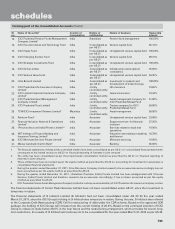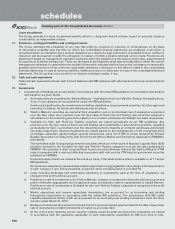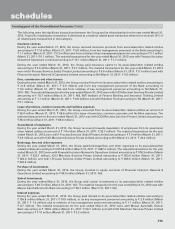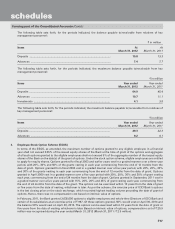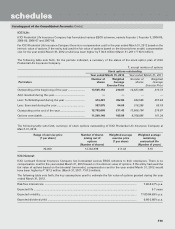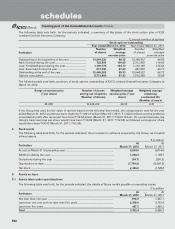ICICI Bank 2012 Annual Report Download - page 149
Download and view the complete annual report
Please find page 149 of the 2012 ICICI Bank annual report below. You can navigate through the pages in the report by either clicking on the pages listed below, or by using the keyword search tool below to find specific information within the annual report.
F71
Accordingly, in cases where the cash flows from security receipts issued by asset reconstruction companies
are limited to the actual realisation of the financial assets assigned to the instruments in the concerned scheme,
the Bank reckons the NAV, obtained from the asset reconstruction company from time to time, for valuation of
such investments at each reporting period end.
i)
The Bank follows trade date method of accounting for purchase and sale of investments, except for government of
India and state government securities where settlement date method of accounting is followed in accordance with
RBI guidelines.
ii) The Bank’s consolidating venture capital funds carry investments at fair values, with unrealised gains and temporary
losses on investments recognised as components of investors’ equity and accounted for in the unrealised
investment reserve account. The realised gains and losses on investments and units in mutual funds and unrealised
gains or losses on revaluation of units in mutual funds are accounted for in the profit and loss account. Provisions
are made in respect of accrued income considered doubtful. Such provisions as well as any subsequent recoveries
are recorded through the profit and loss account. Subscription to/purchase of investments are accounted at the
cost of acquisition inclusive of brokerage, commission and stamp duty. Bonus shares and right entitlements are
recorded when such benefits are known. Quoted investments are valued on the valuation date at the closing
market price. Quoted investments that are not traded on the valuation date but are traded during the two months
prior to the valuation date are valued at the latest known closing price. An appropriate discount is applied where
the asset management company considers it necessary to reflect restrictions on disposal. Quoted investments
not traded during the two months prior to the valuation date are treated as unquoted. Unquoted investments are
valued at their estimated fair values by applying appropriate valuation methods. Where there is a decline, other
than temporary in the carrying amounts of investments, the resultant reduction in the carrying amount is charged
to the profit and loss account during the period in which such decline is identified.
iii) The Bank’s primary dealership and securities broking subsidiaries classify their investments as short-term and
trading or as long-term investments. The securities held with the intention of holding for short-term and trading
are classified as stock-in-trade and are valued at lower of cost or market value. The securities acquired with the
intention of holding till maturity or for a longer period are classified as long-term investments and are carried at
cost. Appropriate provision is made for other than temporary diminution in the value of investments. Commission
earned in respect of securities acquired upon devolvement is reduced from the cost of acquisition.
iv) The Bank’s housing finance subsidiary classifies its investments as current investments and long-term investments.
Investments that are readily realisable and intended to be held for not more than a year are classified as current
investments, which are carried at the lower of cost and net realisable value. All other investments are classified as
long-term investments, which are carried at cost. However, a provision for diminution in value is made to recognise
any other than temporary decline in the value of such long-term investments. Costs such as brokerage, commission
etc. paid at the time of acquisition of investments are included in the investment cost.
v) The Bank’s United Kingdom and Canadian banking subsidiaries account for unrealised gain/loss, net of tax, on
investment in ‘Available for Sale’ category directly in their reserves. Further, in the case of the Bank’s United
Kingdom and Canadian banking subsidiaries, unrealised gain/loss on investment in ‘Held for Trading’ category is
accounted directly in the profit and loss account.
vi) In the case of life and general insurance businesses, investments are made in accordance with the Insurance Act,
1938, the IRDA (Investment) Regulations, 2000, and various other circulars/notifications issued by the IRDA in this
context from time to time.
In the case of life insurance business, valuation of investments (other than linked business) is done on the following basis:
a. All debt securities and redeemable preference shares are considered as ‘held to maturity’ and accordingly
stated at historical cost, subject to amortisation of premium or accretion of discount in the profit or loss
account over the period of maturity/holding on a straight line basis.
b. Listed equity shares are stated at fair value being the last quoted closing price on the National Stock Exchange
(NSE) [in case of securities not listed on NSE, the last quoted closing price on the Bombay Stock Exchange
(BSE) is used].
c. Mutual fund units at the balance sheet date are valued at the latest available net asset values of the respective
fund.
Unrealised gains/losses arising due to changes in the fair value of listed equity shares and mutual fund units are
taken to ’Revenue and other reserves’ in the balance sheet for life insurance business.
In the case of general insurance business, valuation of investments is done on the following basis:
a. All debt securities including government securities and non-convertible preference shares are considered
as ‘held to maturity’ and accordingly stated at amortised cost determined after amortisation of premium or
accretion of discount on a straight line basis over the holding/maturity period.
b. Listed equities and convertible preference shares at the balance sheet date are stated at fair value, being the
lowest of last quoted closing price on NSE or BSE.
c. Mutual fund investments (other than venture capital fund) are stated at fair value, being the closing net asset
value at balance sheet date.
forming part of the Consolidated Accounts (Contd.)
schedules






